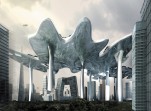Architect and Urbanist Dialogue: Skyscraper’s Role in New Millennium City

Different challenges of the 21st century set for architects a number of tasks, which make them revise the fundamentals of work with an architectural object in a city. How should one build anything in the city of the new millennium? What should form the urban landscape? How much do we need radical high-rise landmarks in it? If they are needed, what should these new buildings be alike? Is there a universal recipe for successful placement of a skyscraper in the city of the future? All these issues keep living in the minds of the modern urbanists and architects, and due to rapid growth of Asian cities in recent years they are becoming even more acute.
In his early, most rebellious creativity period great Thom Mayne (the founder and eternal head of the Morphosis bureau) said: “Building something neutral is always a failure.” Although later he came to a conclusion that there might be exceptions to this rule, many architects are inspired by similar ideas when integrating their objects into the urban landscape. This is quite true when we talk about the appropriateness or inappropriateness of skyscrapers in a particular location of urban development.
For cities with different historical urban-planning contexts, the situation with the appropriateness of new skyscrapers is always different. The challenge thrown out to this context by high-rise buildings is accepted quite differently. A skyscraper as an architecturally iconic building always needs a convincing idea: what is it for? Why is it here? The growth rate of urban areas as well as the level of transport network development and the nature of existing streets routes will be of significant importance for future construction of a full-fledged high-rise ensemble.
Full content of this issue you can read here
The full version of the article can be read in our printed issue, also you can subscribe to the web-version of the magazine
 Text by MARIANNA MAEVSKAYA, contributing scientist at the Research Institute for Theory and History of Architecture and Urban Development (NIITIAG)
Text by MARIANNA MAEVSKAYA, contributing scientist at the Research Institute for Theory and History of Architecture and Urban Development (NIITIAG)


